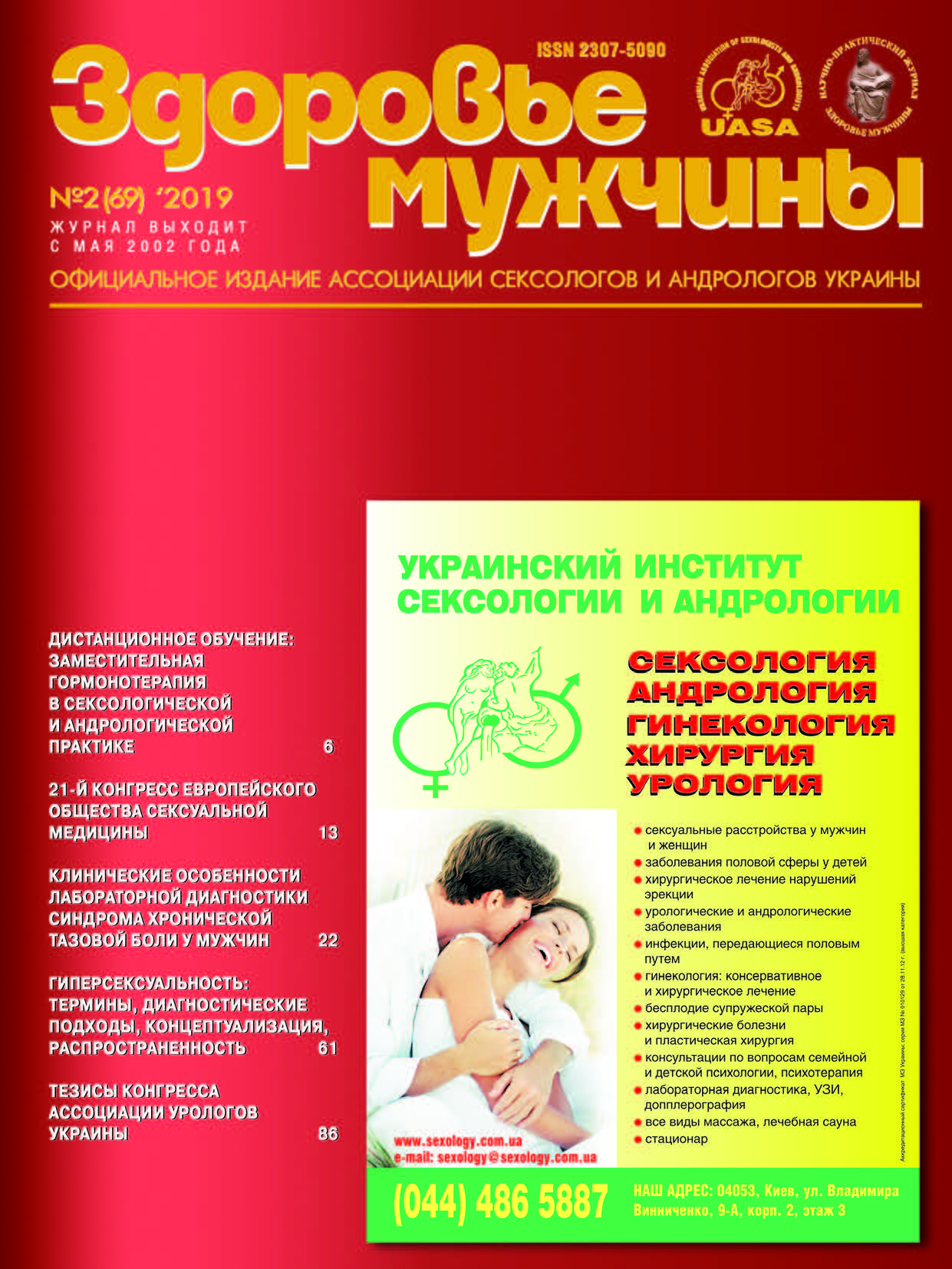Clinical Features of Laboratory Diagnosis of Chronic Pelvic Pain Syndrome in Men
##plugins.themes.bootstrap3.article.main##
Abstract
The article presents the results of a comparative analysis of primary and repeated laboratory examinations of patients with chronic prostatitis/chronic pelvic pain syndrome.
The objective: to evaluate the diagnostic value of cytokines secreting prostate, sperm and post massage urine.
Materials and methods. The study included 34 patients with CP/CPPS aged 18–45 years. Healthy volunteers (n=17) formed the control group. The prostatitis symptoms were assessed by NIH-CPSI scale, depressive symptoms – PHQ-9, and anxiety symptoms – GAD-7. All participants were subjected to microscopic and culture analysis of the expressed prostatic secretion, ejaculate and postmassage urine. Cytokines (TNF-α, IL-1, IL-8, IL-10) were determined using enzyme immunoassay.
Results. Even with a small number of observations there is no complete coincidence of the results of cultural and microscopic examination of the secretion of prostate, ejaculate and post-massage urine, which may be of clinical significance. Significant correlation between the symptoms of prostatitis, anxiety and depression with the leukocytes count as well as the concentration of cytokines in the ejaculate and prostate secretion was not found.
Conclusion. A single laboratory examination of a patient with prostatitis symptoms does not provide sufficient reproducibility of the results and, accordingly, casts doubt on the accuracy of the diagnosis. Developed therapeutic approaches may have an advantage if they take into account the possibility of diagnostic inaccuracies and have a therapeutic effect independently of them.##plugins.themes.bootstrap3.article.details##

This work is licensed under a Creative Commons Attribution 4.0 International License.
Authors retain the copyright and grant the journal the first publication of original scientific articles under the Creative Commons Attribution 4.0 International License, which allows others to distribute work with acknowledgment of authorship and first publication in this journal.
References
Krieger J.N., Ross S.O., Penson D.F., Riley D.E. Symptoms and inflammation in chronic prostatitis/chronic pelvic pain syndrome // Urology. – 2002. – № 60 (6) – P. 959–963.
Nickel J.C., Alexander R.B., Schaeffer A.J., Landis J.R., Knauss J.S., Propert K.J. Leukocytes and bacteria in men with chronic prostatitis/chronic pelvic pain syndrome compared to asymptomatic controls // J. Urol. – 2003. – № 170 (3). – P. 818–822.
Huang T.R., Li W., Peng B. Correlation of inflammatory mediators in prostatic secretion with chronic prostatitis and chronic pelvic pain syndrome // Andrologia. – 2018. – № 50 (2). doi: 10.1111/and.12860. Epub 2017 Aug.
Kroenke K., Spitzer R.L., Williams J.B. The PHQ-9: validity of a brief depression severity measure. J Gen Intern Med. 2001 Sep 16(9):606-613.
Spitzer R.L. et al. A brief measure for assessing generalized anxiety disorder. Arch. Intern. Med. – 2006. – № 166 (10) – P. 1092–1097.
Krieger J.N., Ross S.O., Limaye A.P., Riley D.E. Inconsistent localization of gram-positive bacteria to prostate-specific specimens from patients with chronic prostatitis // Urology – 2005. – № 66 (4). – P. 721–725.
Нуриманов К.Р. Эффективность и безопасность базовой фармакотерапии хронического абактериального простатита // Здоровье мужчины. – 2019. – № 1. – С. 40–45.
Nickel J.C., Roehrborn C.G., O’Leary M.P., et al. The relationship between prostate inflammation and lower urinary tract symptoms: examination of baseline data from the reduce trial. Eur Urol. 2008; 54: 1379-1384.
Schaeffer AJ, Knauss JS, Landis JR, et al. Chronic Prostatitis Collaborative Research Network Study Group. Leukocyte and bacterial counts do not correlate with severity of symptoms in men with chronic prostatitis: the national institutes of health chronic prostatitis cohort study. J Urol. 2002; 168: 1048-1053.
Thakkinstian A., Attia J., Anothaisintawee T., Nickel J.C. α-blockers, antibiotics and anti-inflammatories have a role in the management of chronic prostatitis/chronic pelvic pain syndrome // BJU Int. – 2012. – № 110 (7). – P. 1014–1022.





